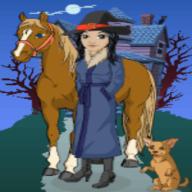我想問halloween 的由來
2006-10-28 5:55 am
plx use enlish
回答 (4)
2006-10-28 5:28 pm
✔ 最佳答案
萬聖節前夕(Halloween)為每年的10月31日,是西方傳統節日。當晚小孩會穿上化妝服,戴上面具,挨家挨戶收集榶果。節日主要流行於英語世界,如不列顛群島和北美,其次是澳洲和紐西蘭。萬聖節前夜英文寫作 Halloween,是 All Hallow Eve 的縮寫,類似於平安夜被稱為 Christmas Eve,是指萬聖節(All Hallow's Day)的前夜。Hallow 來源於中古英語 halwen,與 holy 詞源很接近,在蘇格蘭和加拿大的某些區域,萬聖節仍然被稱為 All Hallow Mas,意思是在紀念所有的聖人(Hallow)那一天,要舉行的彌撒儀式(Mass)。
類似於聖誕節和復活節,萬聖節及萬聖節前夜也來自於基督教對其它宗教的節慶的吸收、改造和重新詮釋。萬聖節前夜起源於不列顛凱爾特人的傳統節慶,在10月的最後一天,他們相信這是夏天的終結,冬天的開始,這一天是一年的重要標誌,是最重要的節慶之一,被稱為「死人之日」,或者「鬼節」。這一天各種惡鬼出沒,死去人們的靈魂也會離開身體,在世間游走,這一天的晚上也就格外危險。人們會把食物放在門口吸引有主的鬼魂靈魂,而為了嚇走邪惡的鬼魂,凱爾特人會載上面具。
當天主教傳教士登陸不列顛諸島的時候,傳教士們為了壓制這種被他們視為異端的德魯伊傳統,就把這一天之後的11月第一天定為萬聖節,紀念天主教的聖人們,希望以此打壓這些鬼怪觀念,所以說是先有鬼節,後有萬聖節。也因為這個原因,實際上萬聖節和鬼節的習俗,主要是在英倫三島和北美的前英屬殖民地,也就是美國、加拿大、澳洲,新西蘭等等。其中美國的萬聖節前夜傳統最初由來自愛爾蘭和蘇格蘭的移民於19世紀傳入,而其他發達國家則於20世紀末受美國流行文化影響而開始慶祝萬聖節前夜。
萬聖節前夜通常與靈異的事物聯繫起來。歐洲傳統上認為萬聖節是鬼魂世界最接近人間的時間,這傳說與中國的盂蘭節類似。
美國明尼蘇達州的 Anoka 號稱是「世界萬聖節之都」,每年都舉行大型的巡遊慶祝。
萬聖節前夕的主題是鬼怪、嚇人,以及與死亡、魔法、怪物有關的事物。通常與萬聖節前夕扯上關係的事物有鬼魂、食屍鬼、巫婆、蝙蝠、黑貓、貓頭鷹、精靈、殭屍、骷髏和惡魔等,還有虛構人物如吸血殭屍和科學怪人。
黑色和橙色是萬聖節前夕的傳統顏色。現代萬聖節前夕的產品也大量使用紫色、綠色和紅色。秋天的元素如南瓜和稻草人等,也成為萬聖節的象徵。
傑克燈是萬聖節前夜最廣為人知的象徵物。在英國和愛爾蘭,當地人原本在挖空的蕪菁中燃點蠟燭造成傑克燈,但移民到美國的人很快便採用南瓜代替,因為南瓜比較大和容易在上面雕刻圖案。不少家庭在南瓜上刻上嚇人的面容,並放在大門口的階級上,傳統上此做法是想嚇走惡魔或妖怪。
萬聖節前夜的主要活動是「不請客就搗亂」(Trick-or-treat)。小孩裝扮成各種恐怖樣子,逐門逐戶按響鄰居的門鐘,大叫:"Trick or Treat!"(意即不請客就搗亂),主人家(可能同樣穿着恐怖服裝)便會派出一些糖果、朱古力或是小禮物。部分家庭甚至使用聲音特效和製煙機器營造恐怖氣氛。小孩一晚取得的糖果往往以袋計,整袋整袋的搬回家。
在蘇格蘭,小孩要糖果時會說:「The sky is blue, the grass is green, may we have our Halloween.」(天是藍色,地是綠色,齊來慶祝萬聖節前夜),然後以唱歌跳舞等表演來博得糖果。
傳統的萬聖節前夜服飾包括殭屍、鬼魂、巫婆、惡魔等。典型的服飾時蓋着一塊剪了兩個眼孔的布扮鬼。在19世紀的蘇格蘭和愛爾蘭,當時的人認為萬聖節前夜鬼魂會來到人間,故會打扮成與鬼魂一樣,讓鬼魂把自己當成同類。近年,萬聖節前夜的裝扮已不限於恐怖,而可以作任何打扮,如扮成電視劇或電影明星,以及公眾人物,例如政治家。2004年適逢美國總統選舉,喬治布殊和克裡成為美國流行的萬聖節前夜打扮。而2001年九一一襲擊事件後,消防員、警察等成為小孩的扮演對象。據估計,2004年有大約215萬個美國小孩裝扮成蜘蛛俠,是當年最受歡迎的打扮。
聯合國兒童基金會的「Trick-or-Treat 計劃」在美國、加拿大和墨西哥很普遍。計劃於1950年推出,籌款小錢箱通過學校分發予小孩,讓小孩討糖果時順通收集捐款。據估計,推出以來已籌得超過1.19億美元。
研究機構 BIGresearch 曾為美國全國零售聯盟進行調查,發現53.3%的顧客會為2005年萬聖節前夜購物,平圴消費額38.11美元,較去年高10美元,以此推算,美國消費者為2005年萬聖節支出的金額高達33億美元。
此外,還有「咬蘋果遊戲」(bobbing for apples),參加者設法只用嘴巴咬起漂浮在水上的蘋果。
在愛爾蘭,有一種傳統占卜遊戲,參加者矇着眼,從放着幾個小碟的桌上選出其中一隻,如摸到的碟盛有泥土,代表來年會有與參加者有關的人過身,如盛有水代表會遠行,盛有錢幣代表會發財,盛有豆代表會窮困,等等。在19世紀的愛爾蘭,少女會在灑有麵粉的碟上放蛞蝓,而蛞蝓爬行的痕跡會是少女將來丈夫的模樣。
在北美,傳說如果未婚女子在萬聖節前夜坐在黑暗的房間中,便可以在鏡中看見未來丈夫的樣貌。不過,如果她們將於結婚前死去,鏡中便會出現一個頭骨。這個習俗自19世紀後期已經非常流行,也有相關的賀卡售賣。
說鬼故事及看恐怖片是萬聖節派對中常見的活動。以萬聖節為主題的電視特輯通常在萬聖節假期當天或之前播放,對象多數是兒童。
由於萬聖節前夜臨近蘋果的豐收期,太妃糖蘋果(toffee apples)成為應節食品。製法是把蘋果插上竹籤,然後手持竹籤把蘋果放在糖漿中轉動,有時會再粘上果仁。從前,各家各戶會準備太妃糖蘋果送給小孩,但當傳聞有人把大頭針和刀片放入蘋果中,送太妃糖蘋果的習慣逐漸消失。雖然大部分個案只是惡作劇,而真實個案中小孩也只是受輕傷,但是不少家長仍然以為在蘋果中放刀片是十分普遍的。
其他特色食品還有:
粟米糖 en:candy corn
熱蘋果酒
烘南瓜子
在古凱爾特人的信仰裡,新的一年於11月1日開始,或稱薩溫節(Samhain)。正如比較短的白天象徵新一年的開始,日落亦象徵新一天的開始;所以每年收割的節慶於10月31日晚上開始。不列顛群島的德魯伊教徒會燃點農作物作為祭品,而當他們圍著火堆跳舞時,太陽季節便會完結而薩溫節隨即開始。
11月1日早上,德魯伊把火堆中仍在燃燒的炭燼分給每一家,用來點燃新的廚房火焰。這些火焰是用來讓家裡保持溫暖,並且趕走惡靈。因為此時被認為是一年中連接陰陽世界無形之門開啟且兩個世界可能產生相互溝通的時刻。
大部分的基督教徒認為萬聖節沒有重要的宗教意義,只把這節日當作是普通的節慶看待。
2006-10-31 9:51 pm
Halloween is a tradition celebrated on the night of October 31, most notably by children dressing in costumes and going door-to-door collecting sweets. It is celebrated in parts of the Western world, though most commonly in the United States, Canada, the UK, Ireland, Puerto Rico, and with increasing popularity in Australia and New Zealand. Halloween originated among the Celts in Ireland, Britain and France[1] as the Pagan Celtic harvest festival, Samhain. Irish, Scots, Calan Gaeaf in Welsh and other immigrants brought versions of the traditions to North America in the 19th century. Most other Western countries have embraced Halloween as a part of American pop culture in the late 20th century.
The term Halloween, and its older spelling Hallowe'en, is shortened from All-hallow-even, as it is the evening before "All Hallows' Day"[2] (also known as "All Saints' Day"). In Ireland, the name was All Hallows' Eve (often shortened to Hallow Eve), and though seldom used today, it is still a well-accepted label. The holiday was a day of religious festivities in various northern European Pagan traditions, until Pope Gregory III moved the old Christian feast of All Saints Day to November 1 to give Halloween a Christian interpretation . Halloween is also called Pooky Night in some parts of Ireland, presumably named after the púca, a mischievous spirit.
...........
去http://en.wikipedia.org/wiki/Halloween 到看詳細資料。
-----------------------
What I know from Halloween
In the US, American kids always go to trick or treating. They always dressed up as a witch, princess, whatever character they want to. They will be get together with ttheir friends and go to every houses to get candy. Usually people give out chocolate bars, milky way, lifesavers, and other kinds of hard candy & soft candy. In some places (like where I lived), those bad kids will throw those rotten eggs, obviously its not good.
And family will put a pum*****in outside their house
The term Halloween, and its older spelling Hallowe'en, is shortened from All-hallow-even, as it is the evening before "All Hallows' Day"[2] (also known as "All Saints' Day"). In Ireland, the name was All Hallows' Eve (often shortened to Hallow Eve), and though seldom used today, it is still a well-accepted label. The holiday was a day of religious festivities in various northern European Pagan traditions, until Pope Gregory III moved the old Christian feast of All Saints Day to November 1 to give Halloween a Christian interpretation . Halloween is also called Pooky Night in some parts of Ireland, presumably named after the púca, a mischievous spirit.
...........
去http://en.wikipedia.org/wiki/Halloween 到看詳細資料。
-----------------------
What I know from Halloween
In the US, American kids always go to trick or treating. They always dressed up as a witch, princess, whatever character they want to. They will be get together with ttheir friends and go to every houses to get candy. Usually people give out chocolate bars, milky way, lifesavers, and other kinds of hard candy & soft candy. In some places (like where I lived), those bad kids will throw those rotten eggs, obviously its not good.
And family will put a pum*****in outside their house
2006-10-28 5:59 am
Halloween (IPA pronunciation: [hælə'win], [hælo'win]) is an observance celebrated on the night of October 31, most notably by children dressing in costumes and going door-to-door collecting candy. It is celebrated in much of the Western world, though most common in the United States, Puerto Rico, Republic of Ireland, the United Kingdom, Canada, and with increasing popularity in Australia and New Zealand. Halloween originated in Ireland as the pagan Celtic harvest festival, Samhain. Irish, Scots and other immigrants brought older versions of the tradition to North America in the 19th century. Most other Western countries have embraced Halloween as a part of American pop culture in the late 20th century.
The term Halloween, and its older spelling Hallowe'en, is shortened from All-hallow-even, as it is the evening before "All Hallows Day"[1] (also known as "All Saints' Day"). In Ireland, the name was All Hallows Eve (often shortened to Hallow Eve), and though seldomly used today, it is still a well accepted label. Halloween was also sometimes called All Saints' Eve. The holiday was a day of religious festivities in various northern European pagan traditions, until it was appropriated by Christian missionaries and given a Christian interpretation. In Mexico November 1st and 2nd are celebrated as the "Día de Los Muertos" (Day of the Dead). Halloween is also called Pooky Night in some parts of Ireland, presumably named after the púca, a mischievous spirit. In Australia it is sometimes referred to as "mischief night", by locals.
Halloween is sometimes associated with the occult. Many European cultural traditions hold that Halloween is one of the liminal times of the year when the spiritual world can make contact with the physical world and when magic is most potent (e.g. Catalan mythology about witches).
參考資料:
http://en.wikipedia.org/wiki/Halloween
The term Halloween, and its older spelling Hallowe'en, is shortened from All-hallow-even, as it is the evening before "All Hallows Day"[1] (also known as "All Saints' Day"). In Ireland, the name was All Hallows Eve (often shortened to Hallow Eve), and though seldomly used today, it is still a well accepted label. Halloween was also sometimes called All Saints' Eve. The holiday was a day of religious festivities in various northern European pagan traditions, until it was appropriated by Christian missionaries and given a Christian interpretation. In Mexico November 1st and 2nd are celebrated as the "Día de Los Muertos" (Day of the Dead). Halloween is also called Pooky Night in some parts of Ireland, presumably named after the púca, a mischievous spirit. In Australia it is sometimes referred to as "mischief night", by locals.
Halloween is sometimes associated with the occult. Many European cultural traditions hold that Halloween is one of the liminal times of the year when the spiritual world can make contact with the physical world and when magic is most potent (e.g. Catalan mythology about witches).
參考資料:
http://en.wikipedia.org/wiki/Halloween
2006-10-28 5:58 am
Origin ten thousand holies All Saints' Day on All Saints' Day are on annual October 31, dress up kind of ' the spirit ''s mould ' the spirit ' on the same day evening, the more frightful the better. Child the getting busier from house to house it take candy, it and does not forget not for sentencing ' Trick or Treat,' eat candy just,All Saints' Day how on earth come? In fact Roman Catholic Church inside, November 1 is holy festivals, November 2 is All Souls' Day every other day, or translate into and recall persons who die festival, can be said to be the origin of All Saints' Day. It is a sage that the Roman Catholic Church seals some believers with moral character of the superelevation before death , in order to cite those believers , exist side by side for models followed of other believers. But because there are actually many believers with outstanding moral character , just unknown by the people, if not having no person smelling to those, the church has not set up it as the sage , seem a little unfair , in one holy that day such as festival , commemorate all teach into sage that confer titles of nobility on and should it seals to be sage but the believer of the canonization of Saints. In fact , counted century as early as the Christian era ago, Karl special people (Celts, live in Scotland , Willes and Irish and other places) relieve oneself on October 31, celebrate a festival called ' Samhain '. Because at the end of October, living people's world will become fuzzy with the boundary line dying between people's world, so spirit of the dead very apt to enter living world of people, turn on legend picture very much , spirit of door the seventh lunar month with us. That day, everybody will wear the unusual or exotic dress, paraded outside, hope to frighten the fatherless wild spirit of mood in the outside away. As for the origin of the pumpkin light , relate to a legend of Irish. Have a person who is Jack in ancient times according to legend, drunk from morning till night. Probably drunk one day, unexpectedly coax Satan on the tree , also let Satan carve a cross on the tree, Satan was stranded coming from head to foot on the tree as a result. Later on Jack discusses the condition with Satan, if Satan can guarantee that he will not enter the hell after dying , will make Satan come down , Satan really promises. But he does not enter the hell , can't also enter the paradise , have to go around ceaselessly in dark world . Satan gives him a rutabaga to dig the empty lantern made, the charcoal fire is put inside, let him can find the way in dark world. This kind of lantern is called Jack-o-Lantern, Irishmans will all carry this kind of lantern while celebrating All Saints' Day. Made of rutabaga (turnip ) originally, Irishman immigrant reach U.S.A. later on, find that it is easier to carve the pumpkin, so the rutabaga light has been turned into a pumpkin light. Meaning of this word as for Halloween, come from All Hallows Eve (Hallows means sages ), namely mean for the all holies evening before that day in festival of November 1.
收錄日期: 2021-04-18 19:59:30
原文連結 [永久失效]:
https://hk.answers.yahoo.com/question/index?qid=20061027000051KK04327



